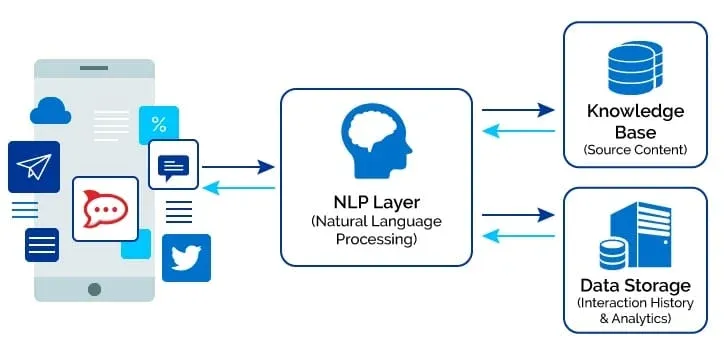Building a compelling conversation with customers can often feel like an art. Yet, with the rise of artificial intelligence and natural language processing, it is becoming more of a science. A key player is the NLP chatbot, a digital conversation tool that doesn’t just send push notifications or pre-set messages, but interacts, understands, and emulates human-like discussions.
Imagine a chatterbox with an extensive knowledge base, offering helpful insights round-the-clock, adapting to different languages and cultures, and continuously learning to serve better. That's what a well-crafted NLP chatbot can do. Unlocking the potential of these smart tools requires a deep understanding of what works best in this arena. This is where a guide is needed to unlock the power of your business's automated chat interface.
Though a high-tech concept, making an NLP chatbot effective isn't just about the technology alone. It's about amalgamating technology with effective strategies; it's about humanizing machines for rich and satisfying customer interaction. This is where our journey begins.
Understanding the Basics of NLP Chatbots
NLP, or natural language processing, chatbots are designed to interact with customers through text or voice, just like humans do. They use AI (artificial intelligence) to understand and reply to questions and inputs from users. In customer service, this helps make interactions feel more human-like, without needing a person on the other end.

For example, have you ever sent a question to a company through a website chat window? You don't always know if a person or a chatbot replies. That's an NLP chatbot in action. Its main job is to help customers in a quick, personal, and efficient way.
An NLP chatbot learns from experiences, adapting over time to tailor its responses. This means it gets better at understanding and answering questions from people. Plus, it can provide information and resolve issues without bothering human customer service agents. This saves both time and money for the company.
How do NLP chatbots work? They use machine learning (a type of computer program that learns by doing) to grasp intents, emotions, and context behind a user's words. This helps them choose the correct response. They are quite different from rule-based chatbots, which simply follow pre-defined commands.
In short, NLP chatbots make customer service easier for businesses by providing useful support that feels natural and effortless. As a result, customers get quick solutions, and companies benefit from cost savings while maintaining quality interactions.
Way 1: Set Clear Objectives
Before starting with NLP chatbots, it's important to know what you want to achieve. Are you using the chatbot for helpdesk support? Do you want it to guide customers through product selection? Or maybe you're looking to offer general advice? Knowing your goal will guide the bot’s programing.
Write down your objectives. This may be speeding up response times, reducing pressure on customer service staff, or increasing customer satisfaction. Whatever it is, be specific. Each objective should be measurable too. That way, you can track if the chatbot is successful or if it needs tweaking.
Also, consider what the customer wants. They might be looking for quick answers, round-the-clock support, or help completing a purchase. The aim is for the chatbot to help meet these needs.
So, simply put, set your goals clear and train your chatbot accordingly. This will ensure your chatbot offers value to both the business and the customers.
Way 2: Understanding Audience
A crucial step to making your NLP chatbot effective is learning about your customers. Who are they? What issues do they typically face? What language do they use? Discovering these facts will help tailor your chatbot to your audience, making it more useful and relatable.
Start by researching past customer interactions, such as chat logs, support tickets, emails, or phone calls. Look for common questions, concerns, and thoughts. Comprehend the tone, language, and phrases your customers use. This data will help teach the chatbot how to respond more like a human.
Don't forget user demographics, like age, location, language, or occupation. This affects communication style and the information a chatbot needs to provide.
By knowing your audience, you can create an NLP chatbot that speaks their language, answers their questions, and offers fast solutions to their problems, making their experience more satisfying and helpful.
Way 3: Multilingual Support
A great way to reach more customers is to have a chatbot that communicates in more than one language. If your customers speak different languages, a multilingual chatbot will provide better understanding and support.
Think about it. Having a chatbot that can switch between languages depending on the customer's preference can avoid a lot of confusion. It helps in resolving issues faster too. And it shows your commitment to serving a diverse range of customers.
Several chatbot platforms nowadays offer language choices. So it is easier than ever to implement this feature.
Keep in mind, offering multiple languages isn't just about translation. It's also about understanding culture-specific phrases, colloquialisms, and dialects. The more languages and cultures your chatbot can navigate, the more customers it can help. In short, a multilingual chatbot breaks down language barriers and makes your service accessible to a broader customer base.

Way 4: Personalize Conversations
Having an NLP chatbot that personalizes conversations can make a big difference in customer experience. People appreciate when a chatbot feels more like a human. It might be simple things like using their name or recalling past interactions.
To start, train your chatbot to greet users by their names when possible. Make it capable of remembering previous chats, so customers don't have to repeat themselves. This adds a personal touch and makes conversations more efficient.
Additionally, consider teaching your chatbot about customer preferences. If users regularly buy certain products or use specific services, having the chatbot recognize these patterns can help it suggest useful options or give tailored advice.
Remember, the goal is to create an experience that feels like interacting with a thoughtful human, even though it's automated. This personalized approach not only engages customers more effectively, but it also increases their trust and satisfaction with your service.
Way 5: Accessible 24/7
Imagine having a customer service representative always ready to help, day or night. That's what an NLP chatbot can do. Most customers expect quick responses, and many enjoy the convenience of getting help whenever they need it. Therefore, having a chatbot available 24/7 is a big advantage.
Unlike humans, chatbots won't get tired or need breaks. They can answer questions, process orders, or provide information all the time. This means less waiting for customers and more efficiency for your business.
Keep in mind, customers might reach out at any hour, including after normal business hours or on weekends. With an always-on chatbot, they can get assistance right away. This not only improves customer satisfaction but also boosts your business' reputation for dependable service. So remember, being accessible round-the-clock is one of the best ways to serve your customers efficiently.
Way 6: Streamlining Queries
NLP chatbots can streamline queries to create a smoother experience for customers. They can sort out simple queries themselves, and for complex problems, guide the user to the right human agent. This way, when a customer reaches out, the initial filtering is already done - saving time and effort for everyone.
It's like having an assistant who's always ready to help, categorizing each client request from the start. A simple question about pricing can be resolved by the chatbot itself. And a complex technical issue? It can be forwarded to a specialized agent.
So, train your chatbot to organize customer inquiries, solve simple ones, and know when to hand over to a human. This will make the process quicker for customers. It also helps your customer service team focus on the more important issues, enhancing overall efficiency. It's a win-win for everyone.
Way 7: Predictive Analysis
Incorporating predictive analysis into your NLP chatbot can be a game-changer. Predictive analysis studies past interactions and data patterns to anticipate customer needs or future behavior. By doing so, the chatbot can provide helpful suggestions or solve issues before they even become problems.
For example, imagine a chatbot that analyzes customer purchase history to predict when they'll need a replacement item. Or one that offers helpful tips based on the most common questions from past users. These proactive actions make customers feel taken care of and strengthen brand loyalty.
Train your chatbot to analyze the data collected over time. This includes customer interactions, demographics, or preferences. The more information it gathers, the better it becomes at both understanding the user and predicting their needs. Ultimately, a chatbot that uses predictive analysis sets your business apart by offering insightful and valuable assistance.
Way 8: Real-time Support
When customers have a question or issue, they usually want help immediately. That's where an NLP chatbot shines, offering real-time support.
Think about how frustrating it is to wait for email responses or connect to a human agent over a phone call. An NLP chatbot can tackle these pain points, answering queries in real-time.
Train your chatbot to give instant responses, whether it's answering common FAQs, explaining product details or troubleshooting a problem. Offering real-time support keeps customers satisfied and reduces frustration. It also eases the pressure on your customer service team, freeing them up to handle more complex issues.
In summary, an NLP chatbot ensures your customers get instant, helpful support when they need it most. So, remember, being quick and accurate is key for an effective chatbot.
Way 9: Continuous Improvement
Like any technology, your NLP chatbot will need updates and adjustments to stay effective. Continuously improving your chatbot's performance helps it stay helpful and up-to-date with customer needs.
Begin by monitoring chatbot interactions. Review conversations, user feedback, and engagement metrics. Are the responses accurate, conversational, and helpful? Identify what works and what doesn't. Then make the necessary changes.
It's also important to incorporate new information, industry trends, or products into your chatbot's knowledge base. This will keep it relevant and informed.
Remember, the world around your chatbot is constantly evolving. Users' needs, preferences, and language use may change over time. So, always be ready to refine your chatbot's abilities.
In conclusion, think of your NLP chatbot as an ongoing project. This continuous improvement mindset will ensure it remains a valuable support tool for both your customers and your business.
Suggested Reading: The Future of Automation: NLP and Voice Assistants
Conclusion
In the end, the potential of an NLP chatbot is largely defined by how well it covers these aspects. Make it intelligent, approachable, and available around the clock. Keep it multilingual, streamlined, and adaptive.
Don't forget to inject some personality and anticipate customer needs via predictive analysis. Lastly, always seek opportunities for continual improvement. With these guiding ways, your NLP chatbot will not only survive but thrive in today's demanding digital landscape, bolstering your customer engagement while making your business more efficient and responsive.
Always remember, it's not about making machines mimic humans, but enriching customer interactions to drive satisfaction
Frequently Asked Questions (FAQs)
How long does it take to train an NLP chatbot?
The duration can vary based on the complexity of the tasks and the amount of data available. It could take weeks or even months to fully train a sophisticated chatbot.
Can NLP chatbots understand every language?
The capabilities of an NLP chatbot depend on its training. With multilingual training, it can understand various languages. However, the extent of understanding may vary.

Can an NLP chatbot replace human customer service representatives?
While chatbots are powerful, they function best as assistants, facilitating human agents by handling simple, repetitive queries and freeing up agents for complex tasks.
Is it possible for an NLP chatbot to make errors?
Yes, like any technology, a chatbot can make mistakes. However, with continuous monitoring and improvements, the error rate can be reduced.


